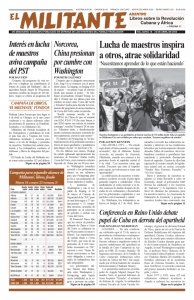The death toll among Palestinians is rising in the Gaza Strip as the Israeli army continues to shoot protesters who approach the border area that Israeli officials have declared off limits. More than 30 protesters have been killed since March 30 and over 1,000 wounded, by live fire from snipers or tanks, tear gas or rubber bullets.
Israel Defense Forces officials say that they are targeting armed individuals and those who try to breach the fence. But Hamas, the ruling party in Gaza that organizes the “March of Return,” says that some of those killed were running away. Palestinian journalist Yaser Murtaja, who wore a flak jacket with the word “PRESS” in large letters, was killed April 6.
“Is a fence more important than a human life?” Israeli human rights lawyer Michael Sfard asked during a phone interview with the Militant April 4.
The March of Return protests culminate May 15, the day after the 70th anniversary of Israel’s declaration of independence. The new U.S. Embassy is due to open in Jerusalem by then. Palestinians mark the same day to commemorate the expulsion of hundreds of thousands from their land.
Hamas’ provocative actions included organizing protesters to burn thousands of tires to create a curtain of smoke April 6, blocking Israeli forces’ view of the border. That protest was smaller than the week before.
Hamas ordered its civilian employees to join the actions at the five camps set up near the border, according to the Financial Times. Much of Gaza has been destroyed in the course of three wars between Hamas and the Israeli government since 2008, a year after the group took over Gaza in bloody street fighting with Fatah.
Charging that aid is diverted to back terrorism, the Israeli and Egyptian governments have imposed severe restrictions on what is allowed to enter Gaza.
While the small capitalist class and high-ranking Hamas officials in Gaza are doing OK, only 10 percent of Gaza’s population has access to safe drinking water. Unemployment is about 50 percent. Some 70 percent of the strip’s 2 million people are dependent on aid from the United Nations Relief and Welfare Agency.
The situation worsened this month when the Palestinian Authority — despite giving lip service to supporting the protest — cut off wages to tens of thousands of its employees in Gaza. Last year it suspended payments to Israel for electricity, leaving residents with power only four hours a day. Now Tel Aviv has banned the import of tires there.
Hamas leader Ismail Haniyeh vowed April 9 that the group will never recognize Israel or make any concessions.
And Hamas’ strategy of trying to get unarmed civilians killed is nothing new. It followed the same course during previous wars to create martyrs that could bolster its support among Gaza’s workers and to get international sympathy in its fight against Israel.
The way the March of Return is being organized is a sign of weakness. The Israeli government has thwarted Hamas’ terror attacks with improved methods of blocking tunnels into Israel and has blocked missiles fired from the territory. And Hamas’ bankrupt course has meant that there have been few actions in the West Bank and Israel opposing the Israeli army assaults on the March of Return. Both the Egyptian and Saudi governments have urged Hamas to scale back the protest.
A Dec. 11 statement on behalf of the Socialist Workers Party National Committee points a course forward: “The political necessity for the Israeli and Arab governments and leaderships of Palestinian organizations to begin immediate talks to recognize both Israel and an independent Palestinian state.”
“Negotiations to reach such an agreement must recognize the right of Jews everywhere to take refuge in Israel in face of the global rise of Jew-hatred and anti-Semitic violence, as well as the unconditional right of the dispossessed Palestinian people to a contiguous, sovereign homeland on territory — including East Jerusalem — conquered and occupied by the Israeli government during the 1967 war.”
“It is along this road that working people of all national backgrounds, religious beliefs and political allegiances in Israel and Palestine can use and defend their space to speak, organize and begin redressing the blood-drenched legacy of imperialist domination and capitalist exploitation.”
“We are for whatever helps working people organize and act together to advance our demands and struggles against the capitalist governments and ruling classes that exploit and oppress us and their petty bourgeois political servants and media apologists,” it says.
A leadership that fought for this course would win working people inside Israel to oppose the embargo of Gaza and give working people there a road forward out of the dead end the Hamas leadership has created.

